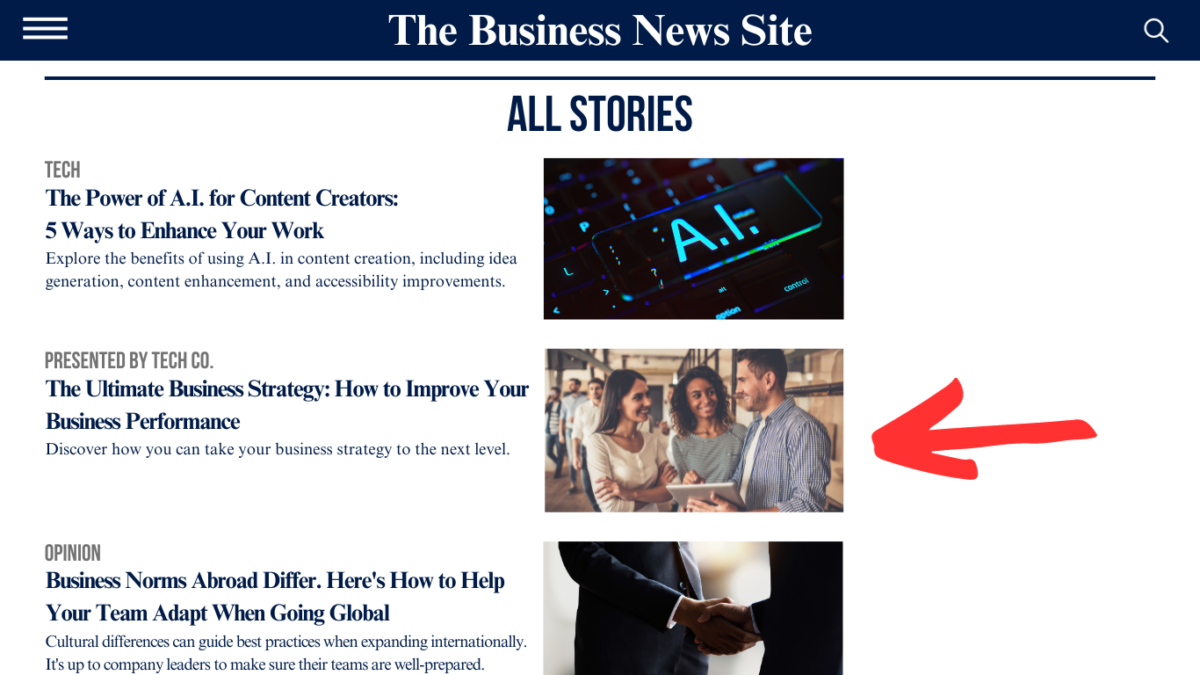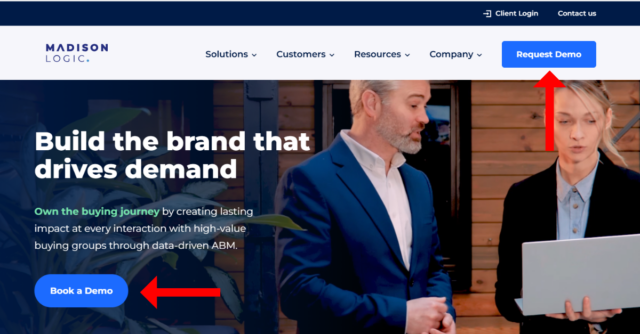
In 2025, the average person sees over 6,000 ads daily. (That’s some serious competition.)
Display advertising is the second-largest digital advertising format in the U.S., with domestic spending projected to hit $78 billion by 2026. To stand out with your display ads, you need more than just eye-catching visuals—you need a strong strategy built on proven best practices, then refined through data-driven insights to maximize impact.
When used as part of a data-driven, multi-channel account-based marketing (ABM) strategy, display ads are critical in reinforcing key messaging and delivering content to target accounts. It’s also a proven method for generating higher click-through rates, web engagement, and pipeline. In this article, we’ll explore the eight essential display advertising best practices you can implement immediately to boost engagement, conversions, and overall ABM performance.
Display Advertising Formats and Types
Display advertising leverages visual elements like different images, videos, and animations to promote products or services across the internet on websites, social media platforms, and mobile apps. The goal? Capture buyers’ attention and encourage them to click through to a landing page or take a specific action.
Here, we’ve rounded up the most effective display ad formats—ones you’ve likely used as a B2B marketer or encountered firsthand.
Banner Display Ads
Banner display ads are the most common type you will encounter online. These ads consist of static or animated images, often in rectangular or square formats, strategically placed to grab attention and drive clicks.
To get started with banner ads, you’ll need a few key elements:
- Text: Keep it short, clear, and compelling. Focus on key benefits, unique pinpoints, or strong value propositions.
- CTA (call to action): Your CTA should be bold, action-driven, and easy to spot. Use phrases like “Get started,” “Try for free,” and “Book a demo.”
- Branding: Incorporate your logo, brand colors, and fonts to ensure consistency and recognition across all ad placements
- Ad Size & Format: Use the most effective banner sizes, including: 300×250 (Medium Rectangle), 728×90 (Leaderboard), 160×600 (Wide Skyscraper), and 320×50 (Mobile Banner). These dimensions fit well within standard webpage layouts, ensuring better user engagement and ad performance.
Banner ads provide a visual and highly targeted way to deliver personalized messages and content to specific accounts. By tailoring the ad creative and messaging to meet each target account’s unique needs and pain points, you increase your chances of capturing the attention of key decision-makers within those accounts.

Native Display Ads
Native display ads are designed to blend into the content of a webpage, matching the site’s style, format, and user experience. Native ads are presented as organic content on platforms like LinkedIn (the largest social network for B2B buyers), news sites, and blogs, making them less intrusive compared to traditional display ads. This approach ensures that the ads do not disrupt buyers’ experiences but rather complement it by matching the look, feel, and function of the surrounding content.
To get started with native ads, you’ll need a few key elements:
- Text: Keep it relevant and engaging. Use copy that blends with the surrounding content. Focus on providing value, solving problems, or offering useful insights.
- CTA (call to action): Your CTA should feel integrated, and action driven. Encourage users to click with phrases like “Learn more,” “Read full article,” and “Discover how.”
- Branding: Incorporate your logo, brand colors, and fonts to align with the content’s style and tone, ensuring recognition without being disruptive.
- Ad Size & Format: Match the platform’s ad requirements to ensure your native ad blends in naturally. Common sizes include: 600×314 (In-Feed Ad Desktop), 600×600 (In-Feed Ad Mobile), and 640×360 or 1280×720 (Video Native Ads).
A common use case for native ads is to deliver valuable and educational content, such as industry insights, thought leadership articles, or case studies. Doing so positions your brand as a trusted advisor, fosters credibility, and builds relationships with key stakeholders. The discreet nature of native ads also reduces ad fatigue, ensuring that your message stands out amidst the noise.

Retargeting Ads
Retargeting ads follow B2B buyers who have previously interacted with your brand but have not yet converted into customers. These interactions could be visiting a website, clicking on an ad, or downloading an asset. The goal is to leverage retargeting ads to reinforce your brand’s presence and help with target account nurture.
- Text: Craft ad copy that speaks directly to where the user left off. Focus on reminding them of what they viewed and why they should care.
- CTA (call to action): Your CTA should be clear and action-driven, reminding users of what they left behind and encouraging them to take the next step.
- Branding: Incorporating consistent branding in your retargeting ads is crucial to ensure recognition and build trust.
- Tracking Pixel: Install a retargeting pixel (like Facebook Pixel, Google Tag Manager, or a similar tool) on your website. This will track visitors who’ve interacted with your site or specific pages.
This personalized approach helps keep your brand top of mind with potential customers, encouraging them to revisit your website, engage with your content, or take the desired action, such as signing up for a demo or purchasing your solution. Retargeting ads also allow you to extend the conversation and adapt your messaging based on how deeply the account has engaged with your brand previously. It’s a strategic way to maintain a consistent and persuasive touchpoint with potential clients, ultimately increasing the likelihood of conversion while optimizing your ad spend.

Why You Need to Run Display Advertising Campaigns as Part of Your ABM Strategy
Display advertising is a powerful tool when leveraged in multi-channel ABM strategies, enabling you to reach and engage high-value target accounts with precision. Here’s a few reasons why you should incorporate display ads into your ABM approach:
Precise Account Targeting
At its core, ABM is about keeping the account at the center of campaigns, and display advertising plays a crucial role in making that happen. B2B display advertising offers robust targeting capabilities, enabling businesses to serve ads directly to their key accounts with precision. By leveraging intent data to narrow audiences to a specific set of accounts and decision-makers, B2B marketers can maximize ad impact by ensuring their message reaches the right people and improve ROI by focusing ad spend on high-value accounts rather than broad audiences.
Enhanced Personalization
ABM display advertising empowers marketers to deliver highly personalized experiences by tailoring ad messaging and content to each target account’s specific needs, pain points, and interests at every buying stage.
By leveraging data-driven insights, marketers can serve highly relevant ads that align with where an account is in the buying process. For example, if a target account is actively researching cloud solutions pricing, you can serve them tailored display ads that prompt them to book a demo for your secure and scalable cloud storage solutions. This ensures your ads are not only relevant but also resonate with the account’s current needs and their stage in the buyer’s journey.
Multi-Channel Activation
ABM success requires a full-funnel, multi-channel approach that engages buyers at every stage of their journey. From top-of-funnel awareness to engagement and action, down to action, conversion, retention, and long-term customer loyalty, a unified experience across key channels is essential.
Display advertising maintains brand awareness, reinforces messaging, and nurtures target accounts with relevant ABM content throughout the buyer’s journey. Additionally, display complements other ABM channels—such as LinkedIn ads, content syndication, and connected TV—by providing continuous visibility and engagement, ensuring that your brand stays top of mind across multiple touchpoints.
For example, pair display ads with sales outreach and content syndication to create a multi-touch engagement strategy. Running targeted display ads before outbound calls warms up accounts, increasing familiarity and response rates. Meanwhile, content syndication delivers valuable insights to key decision-makers, reinforcing credibility. This unified multi-channel strategy makes buyers more receptive to outreach, leading to stronger connections and higher conversion potential.
8 Best Practices for Account-Based Display Advertising
To maximize the impact of your ABM strategy, it’s essential to approach account-based display advertising with precision and strategy. By implementing best practices, you can ensure your ads reach the right accounts, drive engagement, and support your broader ABM goals. Let’s explore the eight essential best practices you can apply today to improve the efficiency and effectiveness of your ABM program.
#1: Use Data to Target the Right Accounts
An ABM strategy isn’t about targeting all accounts—it’s about focusing on the right ones.
However, to effectively reach the right accounts you need to leverage data. Intent data helps pinpoint key decision-makers and stakeholders within accounts who are researching relevant topics and engaging with your content. By targeting these engaged prospects, you can deliver highly personalized and timely display ads that drive meaningful interactions and accelerate the buyer’s journey.
To best target your ideal accounts, leverage a combination of data sources to identify those with the highest likelihood of making a purchase.
- First-Party Intent Data: Insights from your own website, content engagement, and customer relationship management (CRM) system interactions that reveal active interest.
- Third-Party Intent Data: External signals from publishers, review sites, and industry platforms (like ML Insights) indicating research activity.
- Technographic Data: Insights into the technology stack used by target accounts, such as software, tools, platforms, and IT infrastructure.
- Firmographic Data: Key company attributes such as industry, company size, revenue, and location to ensure alignment with your ideal customer profile (ICP).
Once you have your data, combine all sources to create a unified, data-driven approach that enhances targeting and ABM engagement.
Leverage these insights to further build out:
- Buyer Personas: Identify key decision-makers, their roles, challenges, and motivations. Combining data sources and paying attention to specific attributes like job titles and departments helps you profile and map out buyer personas.
- Personalized Messaging: Craft tailored ad creatives, emails, and outreach strategies that resonate with each persona.
- Channel Strategy: Align the right marketing mix channel strategy (display ads, LinkedIn, content syndication, email, etc.) to maximize reach and impact.
#2: Engage New and Existing Accounts
ABM display advertising isn’t just for acquiring new accounts—It’s also a powerful tool for engaging and growing existing customer relationships. While many marketers focus solely on winning new logos, Forrester research highlights value in existing customer expansion, as it costs up to five times more to acquire a new logo than to expand with an existing customer.
By leveraging data-driven personalization, you can reposition your brand within new buying centers, reach additional decision-makers, and drive upsell or cross-sell opportunities. A strategic approach ensures your messaging resonates with both new and existing accounts, maximizing impact and long-term growth.
#3: Personalize According to Buyers’ Needs
B2B buyer personalization is crucial in ABM to build a stronger relationship with buyers. You need to consistently craft dynamic ads tailored to the unique characteristics of your target accounts to keep them engaged.
You need to analyze multiple data sources to paint the clearest picture of your buyers’ needs and pain points, as well as understand their behaviors and what types of ads catch their attention and drive engagement. Using quality data to understand their challenges, roles, and values allows you to personalize content and messaging based on where they are in the buying journey.
Successful display ads often prioritize depth and focus on nurturing long-term relationships. The key is to authentically engage with your audience, offering valuable insights and solutions that resonate over time. As buyers become more familiar with your brand, your ads continue to reinforce building trust, which leads to more awareness with your target accounts as you nurture them into deeper actions.
#4: Create Eye–Catching Designs
To make your B2B display ads stand out, they must be visually compelling and highly relevant to your audience. Color and design play a significant role in making display ads eye-catching. Ads with strong visual elements and appealing color schemes are more likely to capture attention. Focus on clear, concise messaging paired with eye-catching design to capture attention instantly. Here’s what to include in your designs:
- Color: Bold, contrasting colors to grab attention
- Copy: Clear, concise messaging that communicates value quickly and effectively.
- Quality: High-quality visuals (images, icons, or animations) that complement the message and enhance the ad’s appeal.
- Brand: Brand consistency in design elements to ensure alignment with your overall brand identity.
#5: Craft a Compelling CTA
A strong call-to-action (CTA) is the key to guiding your audience toward the next step in their journey. Whether it’s scheduling a demo, downloading a resource, or exploring your solution further, a clear and compelling CTA prompts immediate action.
A strong CTA typically includes:
- Action-oriented language: Use strong verbs like “Start,” “Download,” “Explore,” or “Schedule.”
- Specific outcomes: Be clear about what happens next like “Get your free report,” “Book your 30-minute demo.”
- Audience relevance: Speak directly to the needs or pain points of your target persona.
- Bold visuals: Ensure it stands out with design cues like color, contrast, or placement.
- Urgency: Add a sense of timeliness or urgency with phrases like “limited time” or “now.”

Strong CTAs not only align with best practices but also echo recent shifts in platforms like Google Ads, which emphasize clarity and relevance in ad experiences. Ultimately, a well-placed, intentional CTA boosts engagement, encourages conversions, and maximizes the impact of your ABM display campaigns.
#6: Leverage a Unified, Multi-Channel Approach
To truly maximize the effectiveness of account-based digital display advertising, use it in a comprehensive multi-channel ABM strategy. Understanding what type of content and messaging works for each channel ensures your messaging and branding remain consistent across all touchpoints, presenting a unified and cohesive experience to your target accounts.
Consider display advertising as a complement to your marketing media mix, enhancing engagement and broadening reach with target accounts. When combined with channels, display ads reinforce messaging and boost visibility, fostering stronger connections and driving better results in your ABM strategy.
Here’s how display ads complement other ABM channels:
- Content Syndication: Distribute valuable content such as whitepapers, eBooks, and case studies across third-party platforms
- Connected TV (CTV): Deliver targeted video ads on streaming platforms, reinforcing brand awareness and engagement
- LinkedIn Ads: Reach decision-makers on LinkedIn with tailored messaging alongside display ad campaigns
- Podcast/Audio Advertising: Build brand awareness through immersive storytelling, complementing visual display ads for a multi-sensory impact
Some of the best account-based marketing campaigns leverage display alongside other channels. For example, through a multi-channel ABM approach, cybersecurity company CrowdStrike uses ABM Content Syndication to attract highly qualified contacts and gain valuable additional information for their sales teams. ABM Display Advertising then helps them surround these prospects with the message that they want to convey.
This approach has proved majorly successful for CrowdStrike, achieving above benchmark lead-to-contact conversions and working with sales to nurture those leads to reach above-benchmark pipeline.
#7: Monitor and Optimize Campaigns Continuously
Continuous improvement is crucial to unlocking the full potential of your ABM campaigns. Harness the power of real-time data to drive ongoing enhancements in your messaging and targeting, resulting in increased reach and engagement.
To refine your approach, routinely delve into the specifics of each account’s most effective channels, content preferences, and advertising receptiveness. A deeper understanding of what works and what doesn’t will enable you to identify campaign optimization opportunities more swiftly, tailoring your efforts to each account’s unique characteristics.
Continuously monitor engagement metrics, including impressions, open rates, site visits, and downloads. These metrics offer valuable insights into how your buying committee is interacting with your ads and how effective your content is in guiding them through the buying journey, helping you fine-tune your strategies for maximum impact.
Moreover, don’t overlook ABM measurement data like pipeline volume, value, and velocity. These ABM KPIs provide marketers with a holistic view of how their campaigns influence the sales pipeline, offering essential insights into the overall effectiveness of your ABM efforts. By continuously monitoring and leveraging this data, you can make informed decisions to refine and enhance your account-based marketing strategy.
#8: Test and Learn, then Test Again
Running A/B tests is a must in display advertising. These tests allow you to pinpoint specific variables, such as creative assets, messaging, and landing pages, that can lead to incremental improvements in your campaigns. Be open to trying different messaging, CTAs, ad sizes, formats, and any other adjustable elements to find what resonates best with your audience.
By continuously experimenting and fine-tuning your approach based on data-driven insights, you’ll stay ahead of the curve and consistently improve the performance of your digital advertising efforts. With limited ABM budgets and critical timelines, it’s essential to identify and scale the ads that resonate most with your audience to maximize engagement and ROI.
Drive Higher Brand Awareness with Display Advertising Support from Madison Logic
Advertising success requires more than just execution—that’s where ABM Display Advertising comes in. With 20 years of experience in digital marketing and ABM strategy, Madison Logic helps brands build high-impact display campaigns that drive real results.
Our proven best practices help marketers:
- Accelerate sales conversion: Shorten the sales cycle with ads that build brand recall and credibility.
- Own the moment: Ensure buyers see your brand as the solution to their needs when they’re ready to purchase.
- Be where your audience is: Drive engagement across buying groups on their preferred channels.
By applying these best practices and incorporating display ads effectively, you can build a full-funnel ABM strategy that aligns with your marketing goals and delivers real, measurable results. Request a demo to learn more about how Madison Logic can help you stay front and center with ABM Display Advertising to drive consideration among decision-makers seeking solutions like yours.




